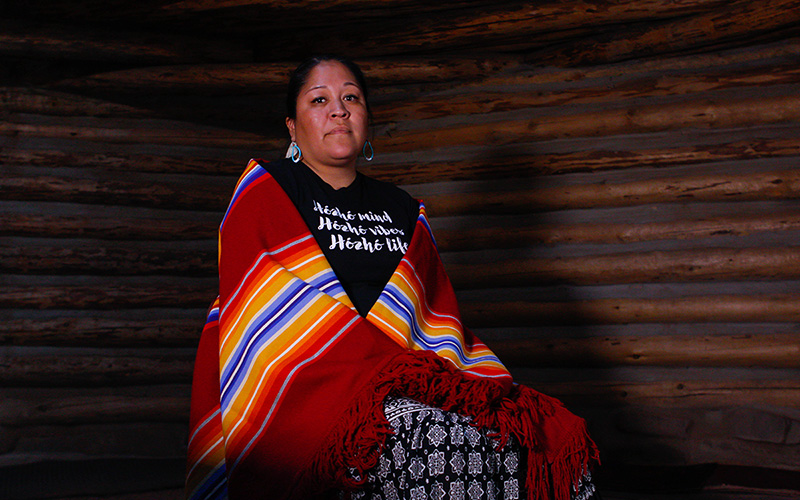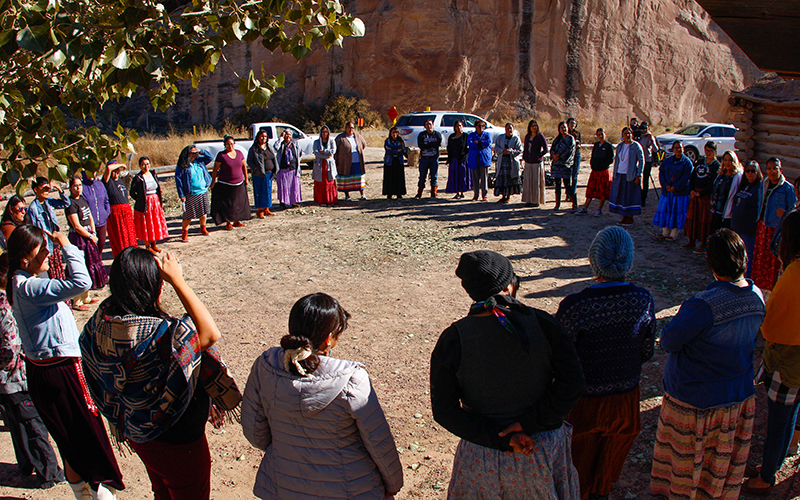PHOENIX – When Nicolle Gonzales gave birth to her three children in a hospital setting, the care felt routine and mechanical. Having worked as a nurse with the Indian Health Service, Gonzales also noticed the gaps in support and accessibility that left many Native American women with insufficient care during pregnancy and birthing.
Her concerns drove her to become certified as a midwife and, in 2015, to launch the nonprofit Changing Woman Initiative to address maternal health disparities in Indigenous women.
The U.S. faces higher rates of pregnancy related deaths than other developed nations, and Indigenous mothers are 2 to 3 times as likely to die as white mothers. The causes are multifaceted, but racism and lack of access are among the factors, experts say.
Changing Woman provides culturally centered care and birthing services both in tribal communities and at a new walk-in clinic in Albuquerque, New Mexico. The initiative also offers training and education so that more Indigenous women can help one another.
As she settled in at her Albuquerque headquarters, Gonzales, who is Navajo, spoke with Cronkite News about the need for policy shifts around maternal health care and the importance of providing culturally appropriate services. The interview has been edited for brevity.
What motivated you to start Changing Woman?
The biggest push was feeling like our Native women needed advocacy on a higher level. I just didn’t feel I was making the changes I wanted to see as a nurse. (As a midwife), I felt like I could be in decision-making spaces and have a little bit more pull in the hospital setting to make decisions with Native families.
It wasn’t until I was in midwifery school that I saw a more clear understanding of the health disparities that Native communities experience around birth care and services – so many gaps around culturally centered care, even just having family present for births, transportation, access to care. A lot of the research around maternal health is focused on death and dying, and really highlights diabetes and hypertension. … But there wasn’t a lot of discussion around why these were outcomes.
Having worked in a hospital as a nurse and then as a midwife later in my career, it’s really hard to make some changes in systems that are already established. I felt like creating a nonprofit to do specific work around direct services, community outreach for training and, of course, policy advocacy work was really necessary. The initial goal was to start a birth center for Native families, and then it grew into something a lot bigger.
What obstacles do Indigenous women face in getting proper care during pregnancy?
There’s lots of little nuances. It can get into racism and implicit bias. … A lot of the care that Native women get is from non-Native providers. They work in a system that might be there for a limited time, and then they leave. When you get people coming in and out of those communities, there’s no ability to build trust. …
In some of these places where there are maternal health deserts, there aren’t a lot of services. … People have to travel long distances. It is really vital to engage those communities in learning those skills themselves.
What are some other barriers to appropriate maternal health care?
The way private sector hospitals function, they try to fit in as many people as they can in a day. They could see 20 prenatal clients in one day, and women get 15 minutes, maybe, in that time to talk to their provider.
(Indigenous women) might have to travel a little bit further just to find a provider to see – that’s a barrier. Making an appointment to get seen – that could be a barrier.
Then there’s the cultural differences, and seeing somebody outside of their community who may not be aware of traditional activities. A Native woman might miss an appointment, and it can be misconstrued that they’re not interested or that they don’t want care because their commitment to their communities takes a lot of their time and maybe they don’t get to all the appointments. But that blame and shame gets placed back on them. …
There’s a lot of little obstacles that they have to overcome. … Maybe she has lots of kids. Maybe some of these clinics don’t have a lot of space for kids and don’t want them there. So how would they get to appointments if they had to always find child care? All of these little things add up, and it makes it more challenging for them to go out to get care.
What policy changes would improve maternal care?
The funding that goes into health services is made on a federal level. We’re not in those spaces to advocate for our needs, so we have to really rely on who’s currently in those positions of power in Washington, D.C. Sometimes those decisions don’t really align with what the community wants or asks, or they’re unaware of what’s happening in the trenches. …
The discussion about maternal health is just now emerging; it’s not something we’ve always talked about. Even during the pandemic, as the tribes were creating emergency response plans to COVID, the discussion around protecting pregnant women as a vulnerable group was not brought up in a lot of those places. … They did acknowledge young children, the elderly and people who have chronic illness as being more at risk for getting COVID, but they didn’t have any specific knowledge around women who are pregnant. That is a gap of knowledge and also contributes to why our outcomes are what they are, too.
Were there other effects related to the pandemic?
The benefit of the pandemic is it highlighted these gaps in care that Native people experience in our communities. Being able to access care for women’s health became more of a problem because a lot of the hospitals and clinics closed services or limited their services. It’s made it even more challenging for women to just come in to get care for anything.
What needs to happen to address maternal mortality in Indigenous communities?
I would say education. There’s lots of discussion around how women of color need to access prenatal care early and often, but there’s no reason or explanation as to why. I feel like that’s why the midwifery model really makes that impact for improved outcomes for women. We spend a lot of time educating them on their bodies and what’s happening around nutrition. …
There’s this history in Native communities where sterilization happened not too long ago. … Part of improving these outcomes includes informed consent – educating them on what labs are going to be drawn, what they’re for and what we’re giving them. The option to say yes or no. And if they do say yes, giving them time to think about it and be part of that decision. I feel like when that doesn’t happen, it contributes to poor outcomes.
How has Changing Woman bettered the lives of the women you’ve served?
It empowered them to learn their traditions in their community about being a mother and raising their children in an Indigenous way. There are teachings in all of our communities about how to do this. It’s just we don’t always have access to that information, or some people don’t have a community of support, like we would like to assume. So our role is really just to create a space so that knowledge can be shared.
The birth center’s kind of a space where people can feel safe to have their babies and practice their traditions of birth. … It’s done in a way that maybe it’s not done in the hospital setting. But there’s more and more women choosing to birth with us than at home. It’s changing their perspective of their role in their community and their role as a mom for their babies, especially when it can be related to our traditions and our teachings about mothering and womanhood.


